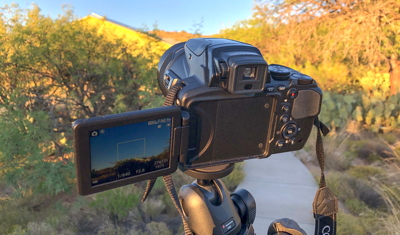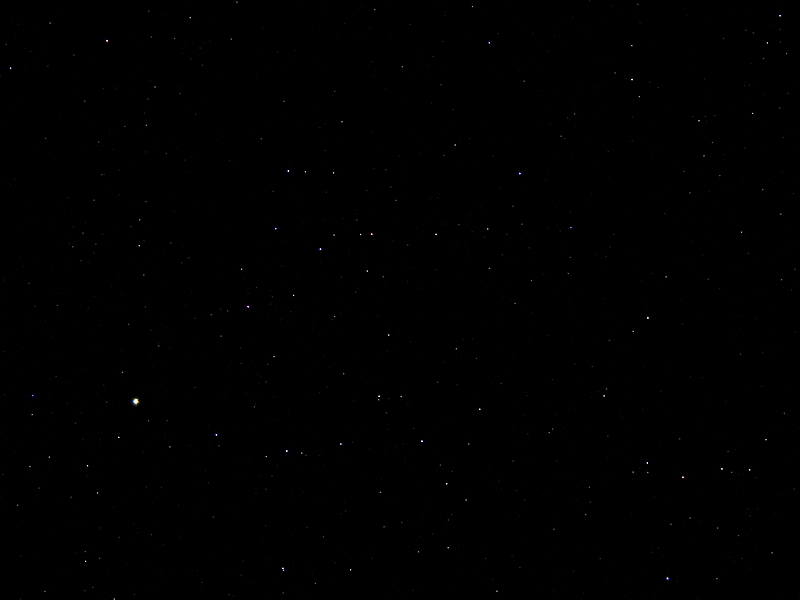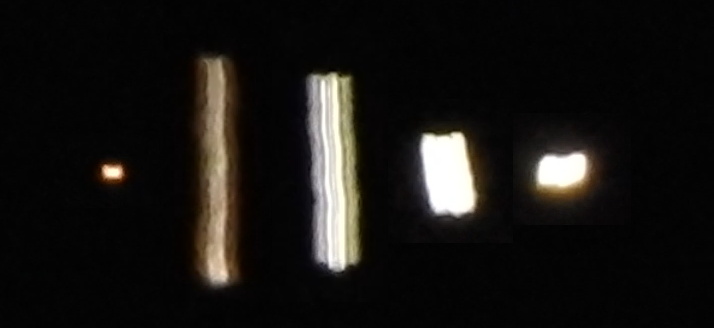Review - Astrophotography with Nikon Coolpix P900, page 2
Posted: 1 June 2018
Updated: 12 June 2018
Coolpix P900 DSLR Astrophotography
As with my Nikon DSLRs, the P900 has P, S, A, and M modes for Programmed auto, Shutter-priority auto, Aperture-priority auto, and Manual exposures. With my DSLRs I most frequently use M for astrophotography. However, there is a distinct drawback with the P900 for long exposure astrophotography: there really is not a LONG exposure capability. Even in manual exposure mode, the Exposure Value (shutter speed + ISO) is fixed. With ISO 3200 or 6400, the slowest shutter speed is 1/2 second. At ISO 1600 it is 1 second, with ISO 800 it is 2 seconds, ISO 400 is 4 seconds, ISO 200 8 seconds, and ISO 100 15 seconds. This obviously limits the camera's ability to capture faint objects. White Balance can be adjusted, including setting a specific color temperature. There is also Noise Reduction: High, Normal (default), and Low. For my astrophotography tests I set NR to Low. Note: when doing long exposures (seconds), a "dark frame" is automatically taken for the camera to do the Noise Reduction, doubling the length of time for an exposure.
Using a remote shutter release when doing astrophotography (or any photography with the camera on a tripod) eliminates hand-induced vibrations. The P900 works with the Nikon ML-L3 wireless IR remote ($13) that I have used with my Nikon D70, D7000, and D7200 DSLR cameras:

I noticed that the "Use Remote" setting turns OFF when some operations with the camera are performed. I found this annoying. A "ML-L3" icon appears in the viewfinder or on the LCD screen when shooting so you can quickly tell if it is ON or OFF. Unfortunately, the Vello ShutterBoss Wireless Remote does not work with the P900.
Unlike DSLRs, the lens on the Coolpix camera is not removable. I do not have an afocal adapter that will work with this model so I was only able to do afocal photos by handholding the lens over an eyepiece. For bright objects short shutter speeds would mean there would be no image blurring due to camera movement. Faint objects (i.e., nebulae and galaxies) would require using an afocal adapter. I set the focus to Infinity for afocal imaging. Very quickly I discovered an issue: it was impossible to get a view of the full eyepiece field-of-view, even when zooming the lens. In fact, the field-of-view was very restricted. For planets this would not be a serious problem, but for the Moon and Sun (with a proper solar filter), afocal imaging will not be that useful. I was able to capture a fairly decent photo of the planet Venus at a gibbous phase (afocal 102X, 1/125sec, ISO 100, some zoom):

An image of Jupiter (afocal 102X, 1/160sec, ISO 1600, some zoom) was not as good:

In general, I suspect that doing afocal astrophotography with the P900 will not yield very good results most times. Using a digital camera afocal adapter would likely be a problem as the lens extends a large distance when zooming.
The P900 does not have illuminated buttons. So at a dark site it will be more challenging to locate the right buttons to press at times. The power ON/OFF button is flush with the camera body so you can not easily find it by feel. Of course, using a red flashlight will help, and with more experience using the camera locating the buttons will get easier.
I mounted the P900 on a camera tripod for a Moon imaging test and used the ML-L3 remote release to trip the shutter. I turned Vibration Reduction OFF and set the focus to Infinity. This is a waning gibbous Moon (f/6.5, 1/400sec, ISO 100, 35mm equivalent FL 2000mm):

That's a good photo of the Moon, showing how well the extreme 83X optical zoom works. Interestingly, one of the "Scene" modes of the P900 is "Moon", which automatically sets the focus to Infinity. I did not use this mode.
With the camera on a tripod I also photographed the Sun. WARNING: never photograph the Sun without using a proper solar filter. I used a Spectrum Telescope Solar Film Filter 67mm that attaches to the lens. With the Sun high in the sky, the movable LCD screen was very handy to view the live image and subsequent photos. As with the Moon image, VR was OFF, focus INF, and the remote release was used. The first photo below is at full wide-angle (f/2.8, 1/100sec, ISO 100). The second photo is at full zoom (f/6.5, 1/100sec, ISO 100).


The Sun is not totally blank. The small sunspot complex AR2712 is just above center. With a proper filter, the P900 can provide nice images of the Sun.
Although I have not yet done this with the P900, I suspect that Moon or Sun transits of the International Space Station (ISS) or perhaps even the ISS in the night sky at the full zoom focal length would make excellent photos. I hope to try this in the future and will report results.
For sky astrophotography I mounted the P900 on an iOptron SkyTracker Pro:


Unlike with my heavier DSLR cameras, no counterweight was needed for the lightweight P900 camera. Both Wide-Angle and full Telephoto lens positions are shown. As discussed on Page 1, the screen can be positioned away from the camera or back onto the camera:


As previously mentioned, there is no Bulb setting for shutter speed. The longest exposure available with the P900 is 15 seconds, but only at ISO 100. As the lens focal length is increased a tracking mount becomes more of a necessity to avoid image trailing due to the Earth's rotation, even with short exposures. (If you don't have a tracking mount you can increase the P900 ISO settings, which reduces the maximum shutter speed.)
I used a Gerd Neumann 67mm Bahtinov Mask as well as the Live View for focusing on a bright star (Spica). This is a full zoom photo of the Mask diffraction pattern. Focusing at full zoom retained the focus at wide-angle.

I pointed the P900 at the planet Jupiter and zoomed to 2000mm (35mm equivalent). This photo (f/6.5, 1/4sec, ISO 100) shows Jupiter and the four Galilean Moons. The inset at the lower left shows Jupiter, cropped from a full frame exposure at f/6.5, 1/60sec, ISO 100, FL 2000mm).

With the SkyTracker Pro polar aligned and tracking, I did some sky astrophotography at 15 seconds, ISO 100, White Balance 5000K. Due to the low EV value it was necessary to add a lot of exposure compensation during post-processing to bring out the stars in the image. This is a f/2.8, wide-angle view of the eastern sky with the constellation of Lyra below center and Hercules at upper right:

The following two photos of the sky were taken at 200mm and 300mm (35mm equivalent) and show good stars:


While doing night sky astrophotography with the P900 is possible as seen above, both the electronic viewfinder and the LCD screen will only show the brightest stars, making for inaccurate pointing. In order to try to image fainter objects in the night sky a GOTO controlled telescope with the camera piggybacked or GOTO tracking mount will be needed.
Summary
For general photography and especially landscapes, wildlife, and aircraft, the Coolpix P900 is a pretty good camera. The lack of Raw images will not likely be a serious drawback for this type of photography. The 83X optical zoom will let you zoom into your subject to capture some amazing details. The camera is lightweight, which is nice when handholding the camera, or mounting on a telescope or a tracking mount.
When used for astrophotography, the Nikon Coolpix P900 has some positives and some negatives. For afocal astrophotography, whether handheld or with an afocal adapter, imaging will be challenging due to eyepiece field-of-view restrictions and the moving lens. With the Exposure Value settings being locked together, imaging is severely constrained to certain shutter speeds and ISO settings. As the ISO is increased, the shutter speed maximum goes down. And even at ISO 100, the maximum shutter speed of 15 seconds will not allow faint objects to be captured unless a lot of images are captured and then stacked. The lack of Raw imaging means that post-processing of images will be limited in the amount and types of editing that are possible. Large bright objects, like the brighter planets, the Moon and Sun (with a proper filter), Lunar and Solar Eclipses, and perhaps the Great Orion Nebula, can be adequately photographed. Night sky astrophotography is pretty much limited to photographing constellations.
If you already use a Coolpix P900 for general photography, give it a try for imaging the Moon and brighter planets. You will be pleased with the results. Photographing constellations is a worthwhile project that can be done with the P900. If you are looking for a general purpose digital camera, especially one with an extreme optical zoom, the Nikon Coolpix P900 is definitely worth considering. Just don't buy it expecting to do afocal imaging with a telescope or faint object astrophotography.
In my original review I mentioned the possibility of imaging the International Space Station (ISS) using the full zoom focal length of 2000mm (35mm equivalent). I was finally able to test the P900 video recordings during three passes of the ISS. The results were not that great. With the shutter speed and ISO settings linked together it was impossible to set the shutter speed faster than 1/2000sec at any ISO when using 2000mm. For handholding and tracking the ISS, motion blur, even at 1/2000sec, is likely to occur. And getting the exposure values correct for the changing brightness of the ISS during a pass is a challenge. Here are three sets of images from the three passes. Some shape and structure of the ISS is visible in some of the images, but overexposure and motion blur were the issues.



Go back to Page 1.
Comments are welcome using Email. If you are on Twitter you can use the button below to tweet this review to your followers. Thanks.
Cassiopeia Observatory Home Page
Copyright ©2018 Michael L. Weasner / mweasner@me.com
URL = http://www.weasner.com/co/Reviews/2018/Nikon_Coolpix_P900/index2.html

